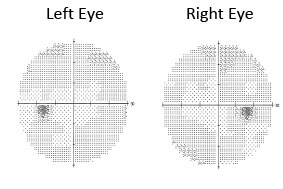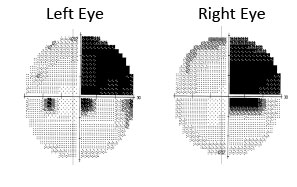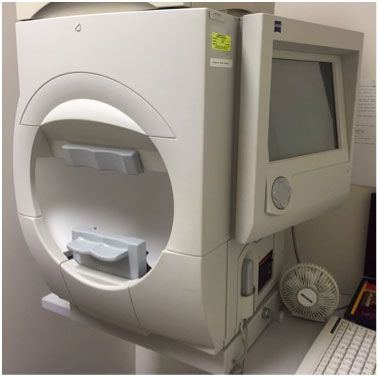Cerebral Vascular Disease Involving Vision: Homonymous Hemianopias
Images enter our eyes and are transmitted through each optic nerve to the brain for processing. Just as the right side of the brain is responsible for the left side of the body, and vice versa, the right side of the brain allows us to see the left side of the world in both eyes and the left side of the brain allows us to see the right side of the world in both eyes.
When there is vision loss on the same side of the world in both eyes, or also known as homonymous hemianopia, the problem is in the brain, rather than the eyes themselves.
Some patients may be not aware of the vision loss, but instead, notice they maybe bumping into things on the affected side or have difficulty reading because they cannot find the beginning or end of a sentence. Other patients may recognize there is vision loss, but not realize it is occurring in both eyes.
If homonymous hemianopia is suspected, visual field testing is obtained to map out what a patient can or cannot see. The most common and thorough method of visual field testing requires patients to sit in front of a machine and press a button whenever they see small dots of light appear.
Each eye is tested individually. The results of the visual test will help your doctor locate where in the brain the disruption in vision exists.
Normal visual fields test results in the right and left eyes. The black spots on the right in the right eye and on the left in the left eye correspond with each eye’s blind spot.
Visual field test results from a patient with a stroke. The blackened areas in the upper right quadrant of vision in each eye corresponds with a left sided stroke the patient suffered.
Automated Visual Field machine
The cause of the visual field defects include strokes, brain tumors, scars in the brain, or bleeding in the brain.
Depending on the cause and length of time of the vision loss, there may be a potential for improvement or even complete recovery in some cases. However, in many cases, vision loss can be permanent.
There are controversies regarding treatments for vision recovery, but they have not been scientifically supported. Attempts to use prisms to try to “expand” vision into the side of vision loss are currently being explored.
Ultimately, learning to adapt to the area of vision loss is what allows patients to return to most of their routine activities.
The ability to drive when patients have vision loss depends on the size and location of the defect. Most states specify the minimum vision requirement and for the state of Massachusetts, a driver is required to have at least 120 degrees of continuous vision across the middle of the vision, in addition to having at least 20/40 vision in the better-seeing eye.
One’s ability to drive is not based on vision alone but also depends on cognition (attention, response time, and memory). Thus, an evaluation at rehabilitation facilities that have driving simulators to assess a patient’s ability to drive may be helpful if a patient has more than just vision loss.
Additional information: view PDF brochure from the North American Neuro-Ophthalmology Society (NANOS).



